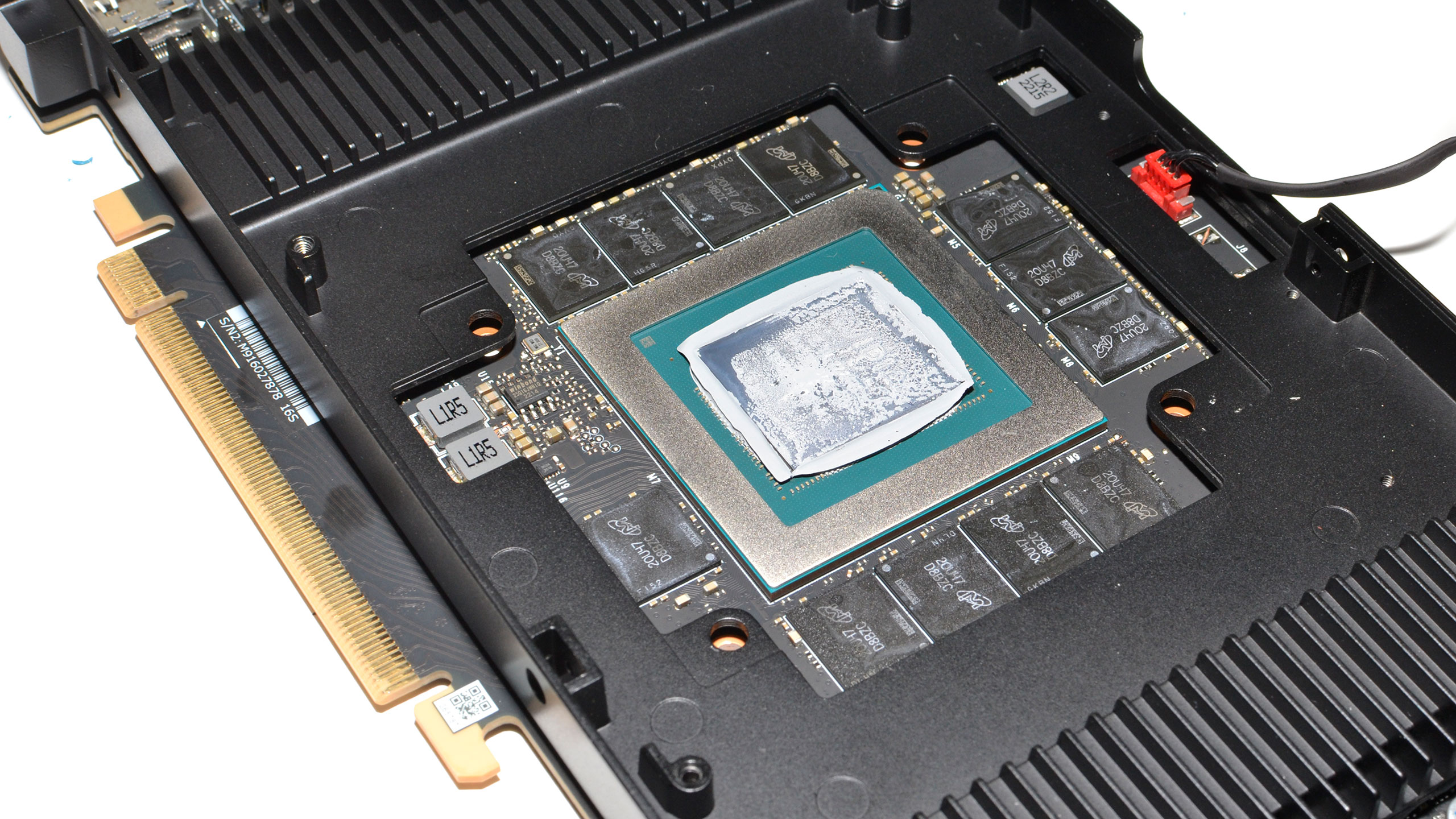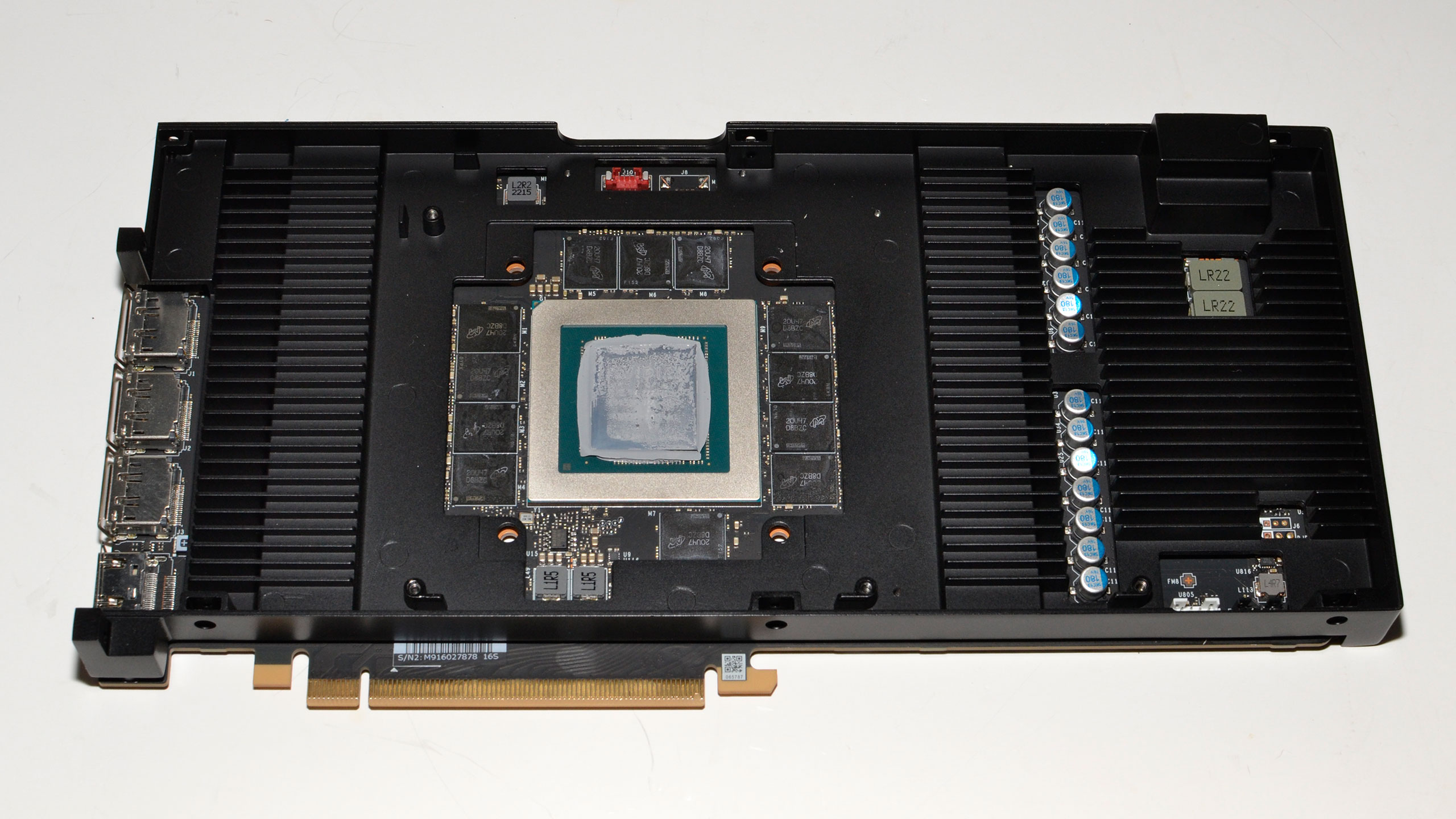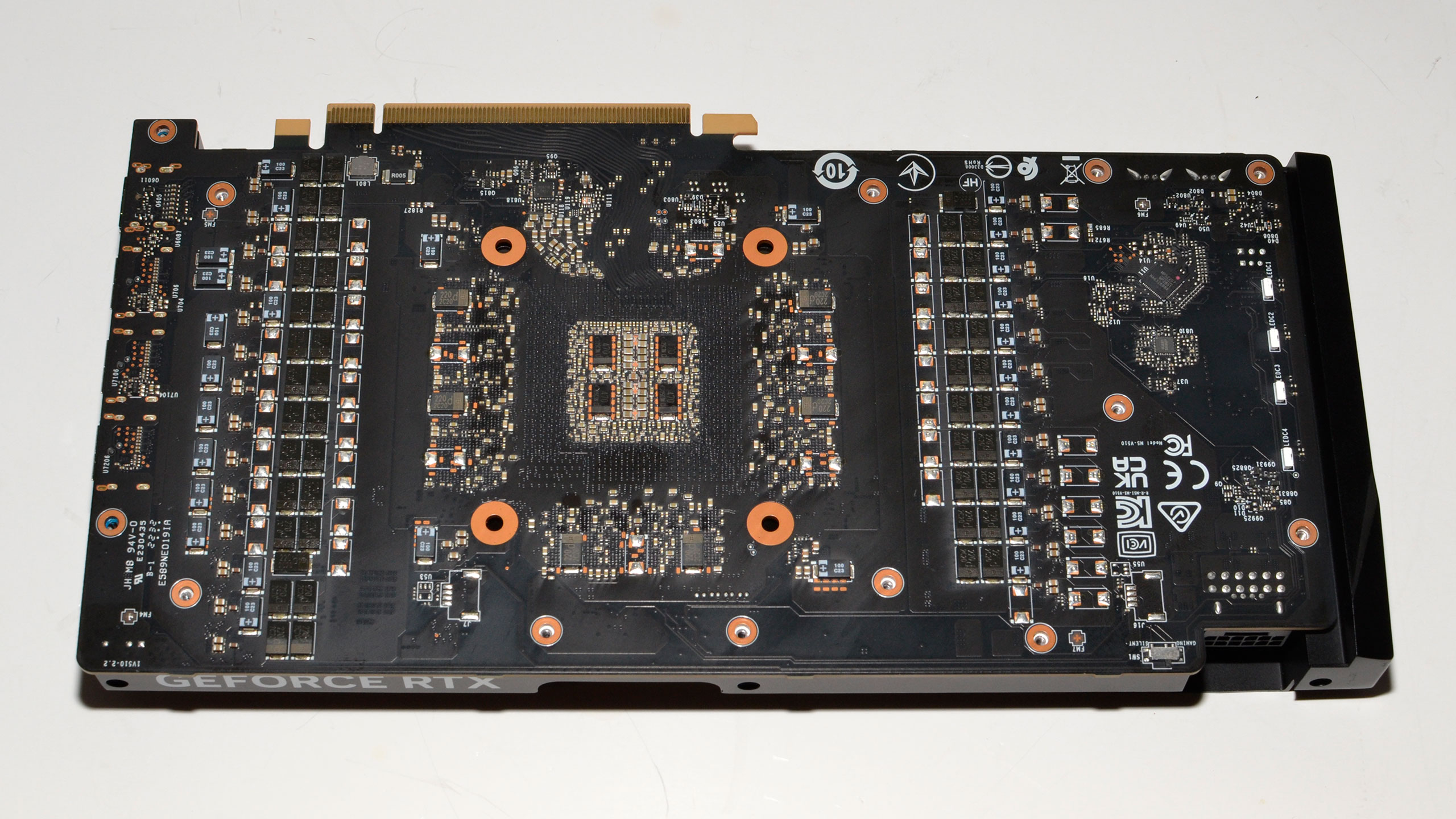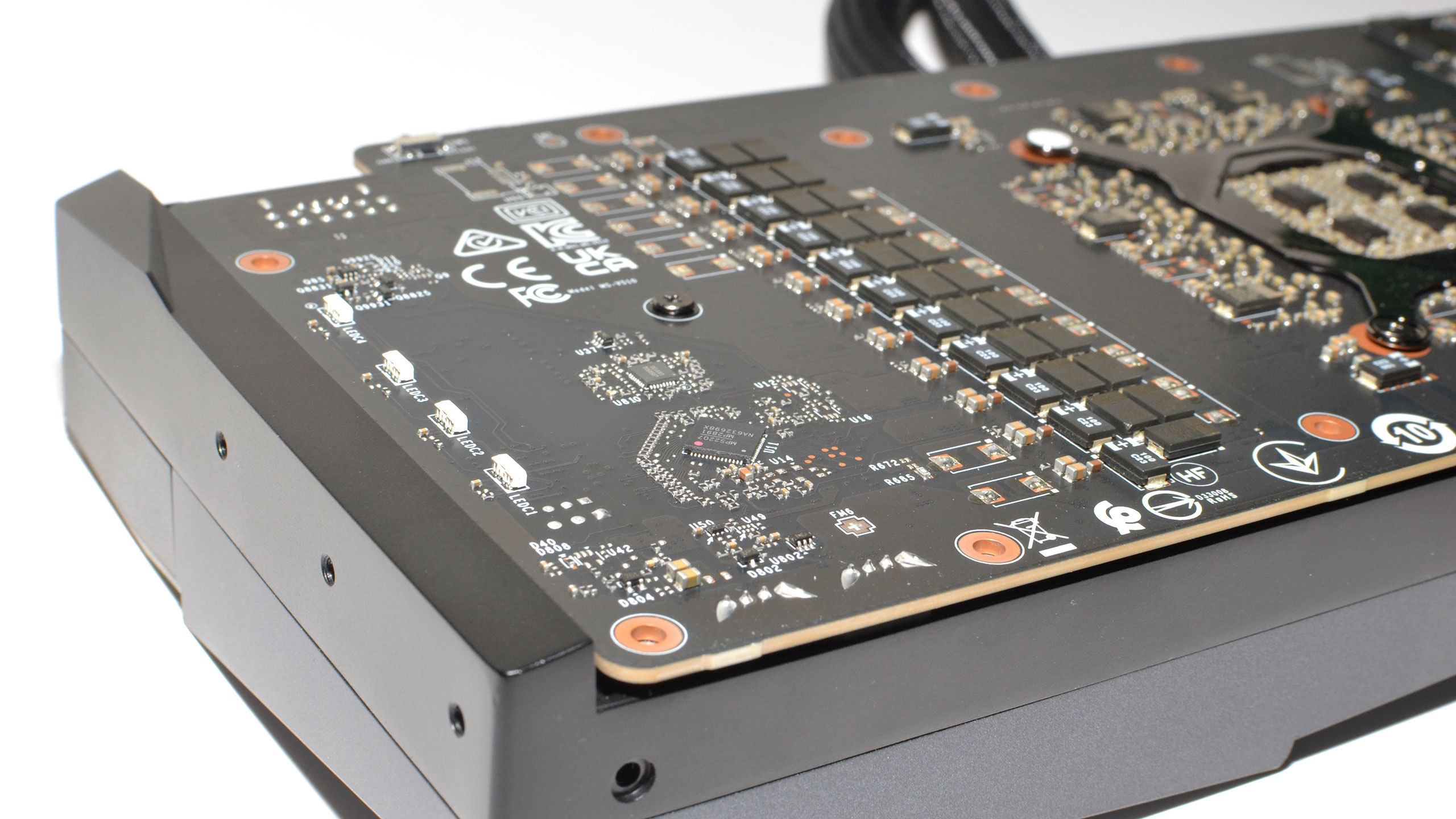Why you can trust Tom's Hardware
MSI RTX 4090 Suprim Liquid X Teardown















Dismantling the MSI 4090 Suprim Liquid X isn't for the faint of heart. It's not difficult, necessarily, but there are a lot more screws than on other cards and the tubing and radiator can definitely get in the way. You end up having to remove the shroud on one side, the backplate on the other, and only then can you get the waterblock off.
Starting with the backplate, there are ten Philips screws securing it — don't remove the four screws for the waterblock mounting plate just yet. With those screws out of the way, the backplate should pop off with a minimum of force, and you can see that the LEDs for the diamond logo are on the PCB, with just a plastic diffuser on the backplate. That's nice because it means there are no wires to deal with so far.
Next, you'll want to remove the cooling shroud. There are six more Philips screws, three on each side. Don't bother with the two extra screws that hold the silver brushed aluminum cover in place, as you don't need to remove that. (Unless you want to replace it with some other decorative cover.)
There's a cable for the fan on the shroud, plus another cable for the LED chevron. Getting at the LED cable right now is almost impossible, however, as the tubing to the radiator is in the way. Do disconnect the fan cable, though.
Now it's time to remove the screws holding the waterblock in place. They're the silver "X" around the center of the card back. Actually, you could leave the backplate in place and still remove the shroud and waterblock if you really want. Anyway, you should be able to carefully pry off the waterblock now — the thermal paste and thermal pads secure it pretty well, so it will require a bit more effort than removing the backplate.
Once the waterblock is out of the way, you can disconnect the pump cable and the LED cable for the shroud. And now you've revealed the GPU, GDDR6X chips, and some of the VRMs. I'll admit that I stopped at this point because the big metal plate/heatsink seemed to be glued in place, and I didn't want to force things. So if you're looking to go beyond this level of disassembly for whatever reason, you're on your own.
You can see MSI used a lot of power phases, which is pretty much the case with all of the 4090 cards. The card also uses plenty of high-efficiency carbonyl inductors (HCI). The GDDR6X memory bears the same "Micron DB8ZC" label as other 4090 cards, but in this case the memory definitely appears to be 21Gbps and not faster 24Gbps memory — though some of that could just be luck of the draw.
- MORE: Best Graphics Cards
- MORE: GPU Benchmarks and Hierarchy
- MORE: All Graphics Content
Get Tom's Hardware's best news and in-depth reviews, straight to your inbox.
Current page: MSI RTX 4090 Suprim Liquid X Teardown
Prev Page MSI RTX 4090 Suprim Liquid X: Design, Teardown and Overclocking Next Page MSI RTX 4090 Suprim Liquid X Manual Overclocking
Jarred Walton is a senior editor at Tom's Hardware focusing on everything GPU. He has been working as a tech journalist since 2004, writing for AnandTech, Maximum PC, and PC Gamer. From the first S3 Virge '3D decelerators' to today's GPUs, Jarred keeps up with all the latest graphics trends and is the one to ask about game performance.
-
Ltsmba $150 extra for essentially 0 performance gain over the FE 4090. So it takes up a little less space in the case, and looks a little more sleek. I'd probably pay $50 extra for that, but definitely not $150 (more actually for some people who bought it when MSI raised the price even higher temporarily).Reply
I thought the point of a water cooled card was to push the limits of what the GPU could do, but it seems its more of a limitation of how much power you can put into the 4090, not how hot its getting.
Water cooling on these things kinda seems completely overkill, unless i'm missing something, which I might be.
Even if I am missing something, I feel bad for anyone who paid a premium for this card and is getting no boost over the FE 4090... -
Phaaze88 It's technically still a 4-slotter, just split in half, with the 2 halves connected by 470mm long tubes. Depending on how you look at it, it's actually larger than some air cooled models...Reply
Msi seems to have slipped up on the contact pressure, because both Kitguru and Paul's HW show the memory being rather warm...
The cards are hard voltage limited by Nvidia. Previously, they were power limited.Ltsmba said:Water cooling on these things kinda seems completely overkill, unless i'm missing something, which I might be.
Without DIY voltage modding, there isn't much on the table. So AIB models don't offer much more than aesthetics compared to the FE. -
Ltsmba That's good to know that it's a voltage limit rather than a power limit.Reply
I guess even so, it ends up being the same result, no benefit to buying a more expensive AIB model.
It's looking more and more clear why EVGA bailed -
A Stoner While performance wise it might not be a gain, if it reduces actual temperatures, then you will be bleeding less heat into your computer room. Not sure if that is the case here, but I am currently running the same watts on my old newer computer than my older old computer and the newer one causes far less heat buildup in the room. The reason is that the CPU and GPU run at much lower top temperatures than the older ones. I think my CPU tops out at 75 water cooled and the GPU at 92. The older one is 100 CPU water cooled or air cooled and 105 GPU.Reply -
JarredWaltonGPU Reply
I thought I included this, but perhaps not. Across the gaming test suite while manually overclocked, I got a maximum GDDR6X temperature of 82C on the MSI card, I think 78C on the Founders Edition, and 72C on the Asus card. Considering how hot 3090, 3080 Ti, and 3080 cards could get on the memory (100-110C), I find 82C temperatures quite nice and am not particularly worried about them. GPU temps do favor the MSI card over the Founders Edition (57.8C MSI compared to 66.9C on the FE), so by that metric MSI "wins." It's just not a particularly important metric IMO, provided the card runs well under 80C GPU and 90C VRAM.Phaaze88 said:It's technically still a 4-slotter, just split in half, with the 2 halves connected by 470mm long tubes. Depending on how you look at it, it's actually larger than some air cooled models...
MSI seems to have slipped up on the contact pressure, because both Kitguru and Paul's HW show the memory being rather warm. -
Phaaze88 Reply
I'm aware that it's well within spec and not something I'd be worried about either.JarredWaltonGPU said:I thought I included this, but perhaps not. Across the gaming test suite while manually overclocked, I got a maximum GDDR6X temperature of 82C on the MSI card, I think 78C on the Founders Edition, and 72C on the Asus card. Considering how hot 3090, 3080 Ti, and 3080 cards could get on the memory (100-110C), I find 82C temperatures quite nice and am not particularly worried about them. GPU temps do favor the MSI card over the Founders Edition (57.8C MSI compared to 66.9C on the FE), so by that metric MSI "wins." It's just not a particularly important metric IMO, provided the card runs well under 80C GPU and 90C VRAM.
It's just, for a liquid cooled model, one would expect improvements across the board compared to air models, but the Suprim Liquid X fails to accomplish this.
I look at this thing and I'm like, "What's the selling points of this thing? What kind of excuses can I come up with to make this a welcome addition to my PC?"
"That's a clean looking gpu shroud." That's it.
I'd personally just get the FE and customize that. -
PlaneInTheSky ReplyAIO liquid cooling doesn't trump large air coolers
Why would it, air coolers today are liquid coolers. There is liquid in those heat pipes.
Air coolers offer liquid cooling in a perfectly optimized closed heatpipe loop that can't leak, there is nothing that can compete with that. -
pixelpusher220 ReplyPlaneInTheSky said:
Why would it, air coolers today are liquid coolers. There is liquid in those heat pipes.
Air coolers offer liquid cooling in a perfectly optimized closed heatpipe loop that can't leak, there is nothing that can compete with that.
It's not active flow though is it? It's heat driven, and sure there's a lot of it, but that's still not the same as actively pushing a larger volume of liquid through the same surface area. -
JarredWaltonGPU Reply
The reason that's a con is because if liquid cooling isn't better, why should you pay extra for it? It's not a question, it's a statement: AIO liquid cooling generally isn't better than a large air cooler, but it does cost more and it involves a lot more moving parts (in the pump). Also, AIO loops can still lose liquid over time, which means that in 5-10 years these AIO cards may not even work properly. I still have an R9 Fury X kicking around and let me tell you, powering that thing up sounds like the pump is going to kick the bucket and that there's a lot of air in the loop now. Air coolers from the same generation don't have that problem. So yes, the fact that an AIO can't clearly beat air cooling is a many pronged problem that I condensed into a simple statement.PlaneInTheSky said:Why would it, air coolers today are liquid coolers. There is liquid in those heat pipes.
Air coolers offer liquid cooling in a perfectly optimized closed heatpipe loop that can't leak, there is nothing that can compete with that.